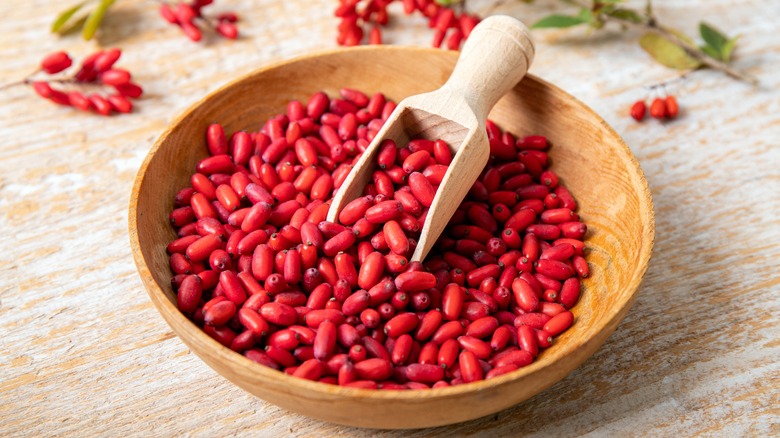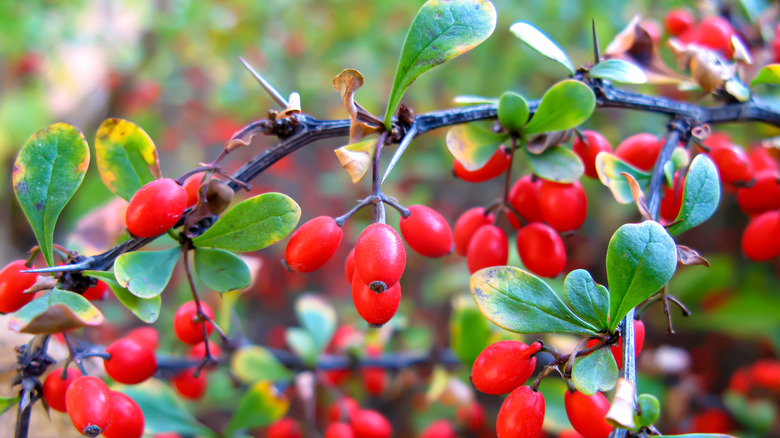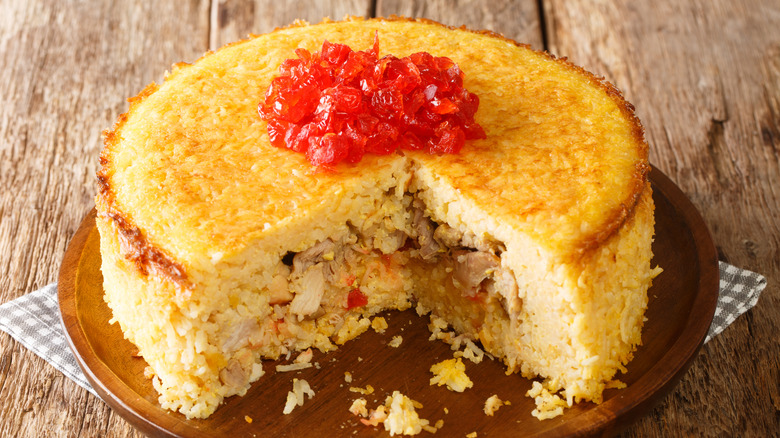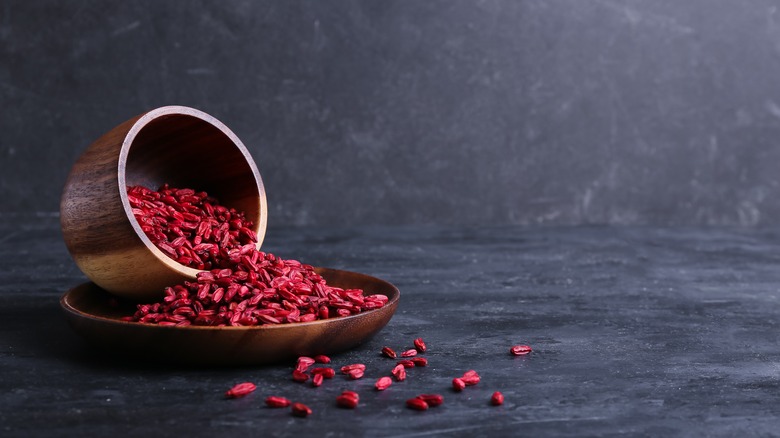Barberries: The Deliciously Tart Berry That's A Staple Of Iranian Cuisine
Fruit is nature's dessert. There is something out there for everyone, whether they prefer tart lemons or sweet cantaloupe, nature provides. According to the Food Timeline, fruit is scientifically classified as the product of a flowering plant that produces pits, seeds, or stones; this means that botanically, tomatoes, eggplants, cucumbers, and more are fruits. However, socially, we have a different perception. We associate savory plant-based produce with veggies, and sweet or acidic plant produce with fruit. One such fruit that fits both the scientific and culinary definition is the barberry.
Unless you're familiar with Iranian cuisine or love learning about fruit, the odds are that you haven't heard of it before. The barberry is recognized for its red berries and sweet-tart flavor and is quite popular throughout the Middle East and parts of Asia (via Cooks Illustrated). The berry is commonly used after being dried, and though it is sweet in nature, its tart characteristics allow this fruit to be used in savory dishes.
What are barberries?
When you look up images of the barberry, you'll stumble across pictures of bright, small, garnet-colored berries hanging from a branch with sharp thorns. Their leaves can be a variety of colors from green to yellow, orange, and red, and they grow all over the globe today. Masterclass says there are four common barberry plants: European barberry, Japanese barberry, American barberry, and Oregon grape. The European barberry (Berberis vulgaris) is the fruit variety most commonly used in Iranian cuisine, whereas the Japanese barberry (Berberis thunbergii) is most often used ornamentally. Barberries are eaten raw, dried, mixed into savory and sweet dishes, and even squeezed into syrups, jellies, and candies.
With all its vast culinary and decorative uses, the barberry also has health benefits! Healthline reports that barberry fruit contains carbs, fiber, vitamins, minerals, and antioxidants. It has been used for centuries as an at-home remedy for diarrhea and inflammation. The fruit comes in supplement form for those who want to experience the barberry's effects.
Barberry cuisine
Barberries are native to Europe, the Middle East, and Asia and have been incorporated into their diets and local dishes for centuries. Because of the notable cranberry-like tartness of barberries, Eat Delights says that the fruit pairs well with dark, heavy meats like lamb and pork, which are also popular in the native regions of the barberry plant. They also hold up well to the intense spices often utilized in Iranian, Indian, and Lebanese rice and curry dishes.
Essential Ingredient reports that the barberry is exceptionally well revered in Iranian culture and is a staple in wedding dishes. It is also an essential ingredient in the rice dish tahchin-zereshk, which also uses heavy amounts of saffron for color and taste. In England, barberries are commonly used to make jams and jellies because of their high levels of pectin, but globally, the berry is tossed into salad, sauce, rub, and tea recipes. It doesn't seem like there is any end to the versatility of this fruit!
Iranian barberries
Because barberries are most commonly grown and used in the Middle East, many Middle Eastern and Iranian food markets will supply them. The Epicentre recommends purchasing dried instead of fresh barberries due to the unfortunate toxicity of some species — it's better safe than sorry! Besides, most recipes call for the use of dried fruit anyway. The barberry's unique acidity allows it to liven up heavier dishes, especially those that use mutton instead of lamb, but if you need to substitute barberries in your recipe, Spiceography suggests using dried cranberries, dried sour cherries, sumac, rose hips, or lemon-soaked raisins if you're really in a bind. These will lend the same attractive red color and a variation of the barberry's unmistakable tartness to your dish.
The barberry is special to Iran, as exemplified by the International Horticultural Congress, which reports that Iran grows 5,000 tons of barberries annually, with the Khorasan province of Iran producing 4,500 of those tons alone, and has been doing so for at least the past 200 years. The barberry has been bringing acidity to the darkest of dishes for decades, so if you ever have the opportunity to eat a traditional Iranian dish, look for the little red fruit that packs a powerful punch.



